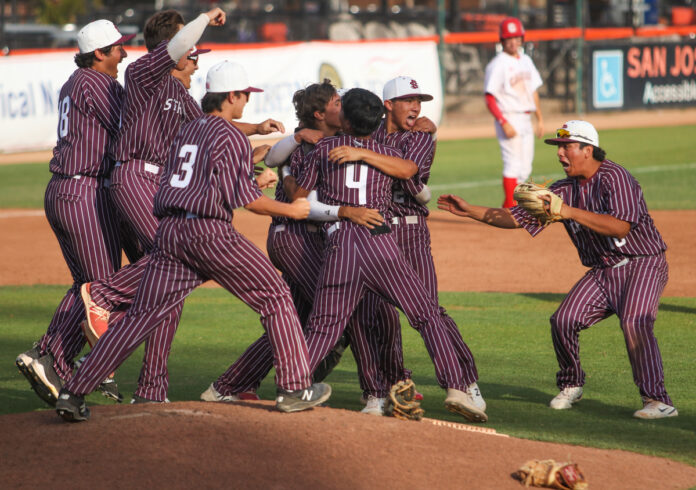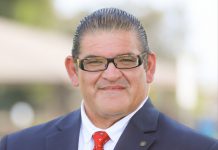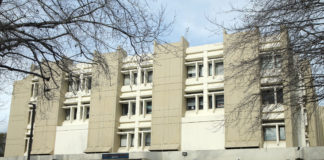
Congratulations St. Francis baseball! I hardly recognize you now. You are proof that the karmic wheel does turn, sometimes slowly, but it does turn. Just to remind, there’s been an orphanage or school on that hilltop since 1869, longer than most things around here.
During my baseball years at Hollister High School (1954-57), St. Francis was known to us as the “Boy’s School” and was one of our annual early-season opponents. Our Coach, Bob Mattson, scheduled St. Francis as an early “confidence builder.” St. Francis was a tiny school, but played a lot bigger.
There were two leagues in this region in the mid-1950s—the Coast Counties Athletic League (CCAL) “A” league, the four larger high schools: Monterey, Salinas, Watsonville and Santa Cruz. Hollister was in the CCAL “B” league with seven schools from Morgan Hill (Live Oak) south to King City including Carmel, Pacific Grove, Gonzales and Gilroy.
Coach Mattson spotted a group of us with promising tools playing on the JV team in 1955 and brought us up to the varsity for that season. By 1956 it was clear that we were going to be damned good as seniors, so Coach tried to put some non-conference games with CCAL A league teams on our schedule, but nobody wanted anything to do with us except Watsonville.
As it is in most levels of baseball, the anchor of our team was a pitcher. His name was Tony Aguirre, a left-hander who threw hard. We had no radar guns available, so we’ll never know how hard. All we knew was that you could hear his fastball when it came at you. It hisssssed. And Tony could make it go where he wanted. We rode that left arm to a league championship. (Tony went on to become Hollister’s beloved Fire Chief, and died in 2000. There is a Tony Aguirre Memorial Park in his honor.)
In the spring of 1957, we made our annual pilgrimage to play St. Francis on their rather scruffy diamond overlooking Kelly Lake. The diamond is still there but there’s nothing scruffy about St. Francis any more.
Just as learning how to lose is one of the most important benefits of athletics, I believe learning how to win is equally as important. Coach Mattson drilled into us the time-honored baseball etiquette of never “showing up” your opponent no matter how badly you’re beating them.
To show his respect for St. Francis, he started the first string, and didn’t pull us until the third inning. We won handily, but the St. Francis players held their heads high and played hard throughout.
We didn’t celebrate at the game’s final out. I think even as young men, before we even knew there was a karmic wheel, we understood that there was a “down” waiting out there for each of us.
On May 7 we came over and beat the tar out of Watsonville, 13 to 4. As this newspaper termed it, we “Walloped” the A-League Wildcats.
We beat all of our CCAL B League opponents twice, and by our last game, a non-league with San Lorenzo Valley (SLV) we were 22 wins and 1 loss. SLV’s baseball program was only a couple of years old and they were on a down.
I am still embarrassed about what we did during that game. I don’t know why Coach agreed to let us do it, but in the fifth inning, we all switched positions and played out the game that way. Very uncool. Talk about “showing up.”
There were no sections or divisions in those days, but many of us played American Legion baseball that summer. I went on to play ball at UC Davis, and then taught history and coached the varsity baseball team at Elk Grove High School.
In 1968 I came to Cabrillo College to teach history. Cabrillo’s President Bob Swenson made it clear that they didn’t need me on the diamond as they’d hired Jerry Fishel, a real baseball coach, as Bob put it with a smile. Come that first Spring, I couldn’t stay away from the baseball field, and Coach Fishel let me work with the pitchers for a bit, but it was soon very clear that I was way over my head and I converted to being a fan.
I would not trade my baseball playing and coaching years for anything. When conducted with the proper old-fashioned protocols and etiquettes, athletics are as transformative as anything that happens in the classroom.
St. Francis’ wheel has turned, but they should never forget those kids who played their hopeful hearts out all those years above Kelly Lake.
Sandy Lydon has been a history teacher for 60 years, the last 54 of which have been at Cabrillo College where he hopes to be teaching a short course or two this Fall. He is a proud member of the Hollister Haybaler Hall of Fame for his teaching career, not his baseball. His column appears on this page the first Friday of each month.












